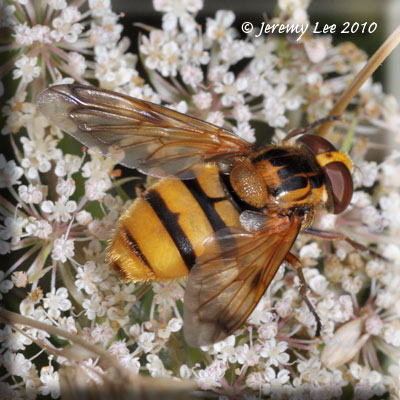
 |
|
Scientific Classifications explained » Amphibians » Ants » Aphids » Bees » Beetles » Birds » Bugs » Butterflies » Caterpillars » Damselflies » Dragonflies » Earwigs » Flies » Frog/Leafhoppers » Fungi » Galls » Grasshoppers » Harvestmen » Hoverflies » Lacewings » Ladybirds » Leaf Mines » Lichens » Mammals » Millipedes » Mosses » Moths » Sawflies » Slugs » Snails » Spiders » Trees » Wasps » Wild Flowers » Woodlice |
UK Nature > Hoverflies > Volucella inanis

Scientific Name: Volucella inanis Common Name: N/A Volucella inanis is one of only two large, hornet mimicking hoverfly species with orangey-yellow and black banded abdomens, and V. inanis differs from V. zonaria in that tergite 2, scutellum and the pale areas on the thorassic dorsum are yellow rather than chestnut coloured. The most compelling identifier is that tergite 2 is yellow in V.inanis. The top of the thorax usually has black stripes which are often fused. V. inanis is also a smaller species, wing length 12.25 - 14.25mm. Found in flower meadows, roadside verges and hedgerows from June to September, peaking in early August. Previously found mainly around London, it has been steadily expanding its range northwards and its range now reaches a line from the Wash to the Severn, although even in this area it is quite local, and infrequent much of the time. |
|

https://www.uknature.co.uk is a website dedicated to showing the immense diversity of UK nature and wildlife. Our vast range of habitats, from lowland arable to snow covered mountains, from storm-ravaged coastlines to peaceful inland freshwater lakes and rivers, from dry, sandy heaths to deciduous and coniferous forests, all these habitats contribute to the abundance of UK nature. We have wild birds in huge numbers either residing or visiting our shores (597 recorded species as at July 2013) and we must also not forget the humble back garden with its grass lawns, flower beds filled with nectar rich flowers, shrubs and trees, all designed to attract huge numbers of insects such as bees, moths, butterflies and hoverflies; and finally the small ponds which provide safe havens for frogs, toads, newts and even slow worms and grass snakes. www.uknature.co.uk is the showcase for my personal passion, photographing uknature in all its glory. I sincerely hope you all enjoy the fruits of my labours. This site and all images contained therein is © Jeremy Lee 2004 - 2021. All Rights Reserved. Site design by Jeremy Lee. Site development & IT Support by Stuart Lee. |